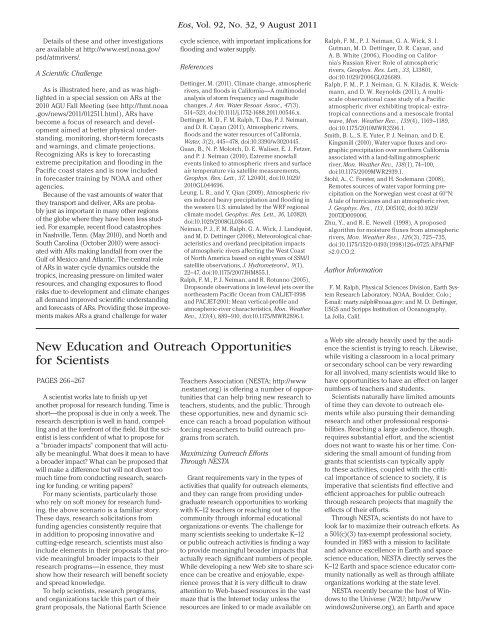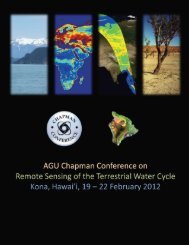Storms, Floods, and the Science of Atmospheric Rivers
Storms, Floods, and the Science of Atmospheric Rivers
Storms, Floods, and the Science of Atmospheric Rivers
Create successful ePaper yourself
Turn your PDF publications into a flip-book with our unique Google optimized e-Paper software.
Details <strong>of</strong> <strong>the</strong>se <strong>and</strong> o<strong>the</strong>r investigations<br />
are available at http://www.esrl.noaa.gov/<br />
psd/ atmrivers/.<br />
A Scientific Challenge<br />
As is illustrated here, <strong>and</strong> as was highlighted<br />
in a special session on ARs at <strong>the</strong><br />
2010 AGU Fall Meeting (see http://hmt.noaa<br />
.gov/news/2011/012511.html), ARs have<br />
become a focus <strong>of</strong> research <strong>and</strong> development<br />
aimed at better physical underst<strong>and</strong>ing,<br />
monitoring, short- term forecasts<br />
<strong>and</strong> warnings, <strong>and</strong> climate projections.<br />
Recognizing ARs is key to forecasting<br />
extreme precipitation <strong>and</strong> flooding in <strong>the</strong><br />
Pacific coast states <strong>and</strong> is now included<br />
in forecaster training by NOAA <strong>and</strong> o<strong>the</strong>r<br />
agencies.<br />
Because <strong>of</strong> <strong>the</strong> vast amounts <strong>of</strong> water that<br />
<strong>the</strong>y transport <strong>and</strong> deliver, ARs are probably<br />
just as important in many o<strong>the</strong>r regions<br />
<strong>of</strong> <strong>the</strong> globe where <strong>the</strong>y have been less studied.<br />
For example, recent flood catastrophes<br />
in Nashville, Tenn. (May 2010), <strong>and</strong> North <strong>and</strong><br />
South Carolina (October 2010) were associated<br />
with ARs making l<strong>and</strong>fall from over <strong>the</strong><br />
Gulf <strong>of</strong> Mexico <strong>and</strong> Atlantic. The central role<br />
<strong>of</strong> ARs in water cycle dynamics outside <strong>the</strong><br />
tropics, increasing pressure on limited water<br />
resources, <strong>and</strong> changing exposures to flood<br />
risks due to development <strong>and</strong> climate changes<br />
all dem<strong>and</strong> improved scientific underst<strong>and</strong>ing<br />
<strong>and</strong> forecasts <strong>of</strong> ARs. Providing those improvements<br />
makes ARs a gr<strong>and</strong> challenge for water<br />
Eos, Vol. 92, No. 32, 9 August 2011<br />
cycle science, with important implications for<br />
flooding <strong>and</strong> water supply.<br />
References<br />
Dettinger, M. (2011), Climate change, atmospheric<br />
rivers, <strong>and</strong> floods in California—A multimodel<br />
analysis <strong>of</strong> storm frequency <strong>and</strong> magnitude<br />
changes, J. Am. Water Resour. Assoc., 47(3),<br />
514–523, doi:10.1111/j.1752-1688.2011.00546.x.<br />
Dettinger, M. D., F. M. Ralph, T. Das, P. J. Neiman,<br />
<strong>and</strong> D. R. Cayan (2011), <strong>Atmospheric</strong> rivers,<br />
floods <strong>and</strong> <strong>the</strong> water resources <strong>of</strong> California,<br />
Water, 3(2), 445–478, doi:10.3390/w3020445.<br />
Guan, B., N. P. Molotch, D. E. Waliser, E. J. Fetzer,<br />
<strong>and</strong> P. J. Neiman (2010), Extreme snowfall<br />
events linked to atmospheric rivers <strong>and</strong> surface<br />
air temperature via satellite measurements,<br />
Geophys. Res. Lett., 37, L20401, doi:10.1029/<br />
2010GL044696.<br />
Leung, L. R., <strong>and</strong> Y. Qian (2009), <strong>Atmospheric</strong> rivers<br />
induced heavy precipitation <strong>and</strong> flooding in<br />
<strong>the</strong> western U.S. simulated by <strong>the</strong> WRF regional<br />
climate model, Geophys. Res. Lett., 36, L03820,<br />
doi:10.1029/2008GL036445.<br />
Neiman, P. J., F. M. Ralph, G. A. Wick, J. Lundquist,<br />
<strong>and</strong> M. D. Dettinger (2008), Meteorological characteristics<br />
<strong>and</strong> overl<strong>and</strong> precipitation impacts<br />
<strong>of</strong> atmospheric rivers affecting <strong>the</strong> West Coast<br />
<strong>of</strong> North America based on eight years <strong>of</strong> SSM/I<br />
satellite observations, J. Hydrometeorol., 9(1),<br />
22–47, doi:10.1175/2007JHM855.1.<br />
Ralph, F. M., P. J. Neiman, <strong>and</strong> R. Rotunno (2005),<br />
Dropsonde observations in low-level jets over <strong>the</strong><br />
nor<strong>the</strong>astern Pacific Ocean from CALJET-1998<br />
<strong>and</strong> PACJET-2001: Mean vertical- pr<strong>of</strong>ile <strong>and</strong><br />
atmospheric- river characteristics, Mon. Wea<strong>the</strong>r<br />
Rev., 133(4), 889–910, doi:10.1175/MWR2896.1.<br />
Ralph, F. M., P. J. Neiman, G. A. Wick, S. I.<br />
Gutman, M. D. Dettinger, D. R. Cayan, <strong>and</strong><br />
A. B. White (2006), Flooding on California’s<br />
Russian River: Role <strong>of</strong> atmospheric<br />
rivers, Geophys. Res. Lett., 33, L13801,<br />
doi:10.1029/2006GL026689.<br />
Ralph, F. M., P. J. Neiman, G. N. Kiladis, K. Weickmann,<br />
<strong>and</strong> D. W. Reynolds (2011), A multiscale<br />
observational case study <strong>of</strong> a Pacific<br />
atmospheric river exhibiting tropical- extratropical<br />
connections <strong>and</strong> a mesoscale frontal<br />
wave, Mon. Wea<strong>the</strong>r Rev., 139(4), 1169–1189,<br />
doi:10.1175/2010MWR3596.1.<br />
Smith, B. L., S. E. Yuter, P. J. Neiman, <strong>and</strong> D. E.<br />
Kingsmill (2010), Water vapor fluxes <strong>and</strong> orographic<br />
precipitation over nor<strong>the</strong>rn California<br />
associated with a l<strong>and</strong>- falling atmospheric<br />
river, Mon. Wea<strong>the</strong>r Rev., 138(1), 74–100,<br />
doi:10.1175/2009MWR2939.1.<br />
Stohl, A., C. Forster, <strong>and</strong> H. Sodemann (2008),<br />
Remotes sources <strong>of</strong> water vapor forming precipitation<br />
on <strong>the</strong> Norwegian west coast at 60°N:<br />
A tale <strong>of</strong> hurricanes <strong>and</strong> an atmospheric river,<br />
J. Geophys. Res., 113, D05102, doi:10.1029/<br />
2007JD009006.<br />
Zhu, Y., <strong>and</strong> R. E. Newell (1998), A proposed<br />
algorithm for moisture fluxes from atmospheric<br />
rivers, Mon. Wea<strong>the</strong>r Rev., 126(3), 725–735,<br />
doi:10.1175/1520- 0493(1998)1262.0.CO;2.<br />
Author Information<br />
F. M. Ralph, Physical <strong>Science</strong>s Division, Earth System<br />
Research Laboratory, NOAA, Boulder, Colo.;<br />
E- mail: marty.ralph@noaa.gov; <strong>and</strong> M. D. Dettinger,<br />
USGS <strong>and</strong> Scripps Institution <strong>of</strong> Oceanography,<br />
La Jolla, Calif.<br />
New Education <strong>and</strong> Outreach Opportunities<br />
for Scientists<br />
PAGES 266–267<br />
A scientist works late to finish up yet<br />
ano<strong>the</strong>r proposal for research funding. Time is<br />
short—<strong>the</strong> proposal is due in only a week. The<br />
research description is well in h<strong>and</strong>, compelling<br />
<strong>and</strong> at <strong>the</strong> forefront <strong>of</strong> <strong>the</strong> field. But <strong>the</strong> scientist<br />
is less confident <strong>of</strong> what to propose for<br />
a “broader impacts” component that will actually<br />
be meaningful. What does it mean to have<br />
a broader impact? What can be proposed that<br />
will make a difference but will not divert too<br />
much time from conducting research, searching<br />
for funding, or writing papers?<br />
For many scientists, particularly those<br />
who rely on s<strong>of</strong>t money for research funding,<br />
<strong>the</strong> above scenario is a familiar story.<br />
These days, research solicitations from<br />
funding agencies consistently require that<br />
in addition to proposing innovative <strong>and</strong><br />
cutting-edge research, scientists must also<br />
include elements in <strong>the</strong>ir proposals that provide<br />
meaningful broader impacts to <strong>the</strong>ir<br />
research programs—in essence, <strong>the</strong>y must<br />
show how <strong>the</strong>ir research will benefit society<br />
<strong>and</strong> spread knowledge.<br />
To help scientists, research programs,<br />
<strong>and</strong> organizations tackle this part <strong>of</strong> <strong>the</strong>ir<br />
grant proposals, <strong>the</strong> National Earth <strong>Science</strong><br />
Teachers Association (NESTA; http://www<br />
. nestanet.org) is <strong>of</strong>fering a number <strong>of</strong> opportunities<br />
that can help bring new research to<br />
teachers, students, <strong>and</strong> <strong>the</strong> public. Through<br />
<strong>the</strong>se opportunities, new <strong>and</strong> dynamic science<br />
can reach a broad population without<br />
forcing researchers to build outreach programs<br />
from scratch.<br />
Maximizing Outreach Efforts<br />
Through NESTA<br />
Grant requirements vary in <strong>the</strong> types <strong>of</strong><br />
activities that qualify for outreach elements,<br />
<strong>and</strong> <strong>the</strong>y can range from providing undergraduate<br />
research opportunities to working<br />
with K–12 teachers or reaching out to <strong>the</strong><br />
community through informal educational<br />
organizations or events. The challenge for<br />
many scientists seeking to undertake K–12<br />
or public outreach activities is finding a way<br />
to provide meaningful broader impacts that<br />
actually reach significant numbers <strong>of</strong> people.<br />
While developing a new Web site to share science<br />
can be creative <strong>and</strong> enjoyable, experience<br />
proves that it is very difficult to draw<br />
attention to Web-based resources in <strong>the</strong> vast<br />
maze that is <strong>the</strong> Internet today unless <strong>the</strong><br />
resources are linked to or made available on<br />
a Web site already heavily used by <strong>the</strong> audience<br />
<strong>the</strong> scientist is trying to reach. Likewise,<br />
while visiting a classroom in a local primary<br />
or secondary school can be very rewarding<br />
for all involved, many scientists would like to<br />
have opportunities to have an effect on larger<br />
numbers <strong>of</strong> teachers <strong>and</strong> students.<br />
Scientists naturally have limited amounts<br />
<strong>of</strong> time <strong>the</strong>y can devote to outreach elements<br />
while also pursuing <strong>the</strong>ir dem<strong>and</strong>ing<br />
research <strong>and</strong> o<strong>the</strong>r pr<strong>of</strong>essional responsibilities.<br />
Reaching a large audience, though,<br />
requires substantial effort, <strong>and</strong> <strong>the</strong> scientist<br />
does not want to waste his or her time. Considering<br />
<strong>the</strong> small amount <strong>of</strong> funding from<br />
grants that scientists can typically apply<br />
to <strong>the</strong>se activities, coupled with <strong>the</strong> critical<br />
importance <strong>of</strong> science to society, it is<br />
imperative that scientists find effective <strong>and</strong><br />
efficient approaches for public outreach<br />
through research projects that magnify <strong>the</strong><br />
effects <strong>of</strong> <strong>the</strong>ir efforts.<br />
Through NESTA, scientists do not have to<br />
look far to maximize <strong>the</strong>ir outreach efforts. As<br />
a 501(c)(3) tax-exempt pr<strong>of</strong>essional society,<br />
founded in 1983 with a mission to facilitate<br />
<strong>and</strong> advance excellence in Earth <strong>and</strong> space<br />
science education, NESTA directly serves <strong>the</strong><br />
K–12 Earth <strong>and</strong> space science educator community<br />
nationally as well as through affiliate<br />
organizations working at <strong>the</strong> state level.<br />
NESTA recently became <strong>the</strong> host <strong>of</strong> Windows<br />
to <strong>the</strong> Universe (W2U; http://www<br />
. windows2universe.org), an Earth <strong>and</strong> space












